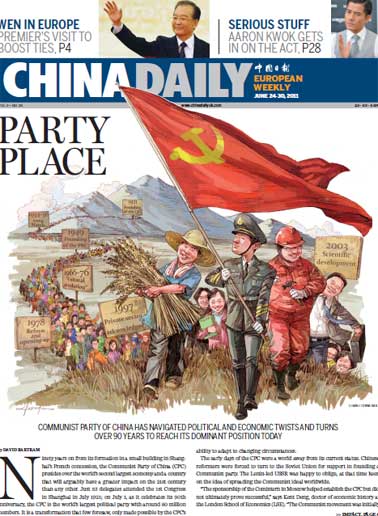Op-Ed Contributors
Fear not China's creative policy
Updated: 2011-06-29 07:57
By Dieter Ernst (China Daily)
Contrary to common misperceptions in the United States, China's present innovation policies do not pose an immediate threat to American leadership in science and technology. In fact, the US retains a strong lead in overall innovative capacity, and China still has a long way to go to close the innovation gap.
China's progress in innovation should be seen as a wake-up call for the US. Rather than fearing China, we in the US need to focus our research and policy debates constructively on how this relationship can be improved. The US government and the private sector need to work together in implementing proactive trade diplomacy that takes into account the diverse forces and conflicting agendas that drive China's innovation policy, and in developing a national strategy to upgrade America's innovation system to cope with the competitive challenges posed by China.
Trade diplomacy and national innovation strategy are interrelated, and hence we need to pursue them simultaneously. Corrective action needs to start now, but there is still time to adjust policies and corporate strategies to the new challenges of an increasingly multi-polar global knowledge economy.
China's innovation policy has resulted massive investments in research and development (R&D) infrastructure and higher education. Since 2000, China has increased its R&D spending by about 10 percent each year. As a result, its share of global R&D spending increased from 9.1 percent in 2008 to 12.3 percent in 2010, while the US' share fell from 35.4 percent to 34.4 percent. China's share is projected to grow even further this year, overtaking Japan as the world's second largest R&D investor.
Since 1998, the number of colleges in China has doubled, and the number of students has more than quintupled to about 6 million. More importantly, China's domestic doctorate awards in science and engineering have increased more than tenfold since the early 1990s, nearing the number of doctorates awarded in the US. Furthermore, China is now among the leading countries in science and technology publications.
China's patent boom is also of particular interest. In terms of total patenting activity, China has overtaken South Korea and Europe, and it is catching up with the US and Japan. In 2009, Chinese nationals accounted for nearly 90 percent of the country's domestic patent applications, indicating that the government's "indigenous innovation" policies have been successful, at least in quantitative terms.
Even so, the gap in innovation capacity persists. China's leadership is very conscious that the US retains a strong lead in R&D spending, patent applications and the per capita number of scientists and engineers. A telling example is that no Chinese company is among the top 20 global R&D spenders in the information technology industry, and China owns just 2 percent of worldwide patents; 95 percent of its patents are domestic.
The main causes of China's continuing innovation gap include severe quality problems in education, plagiarism in scientific work and barriers to private R&D investment. A major weakness of China's policy is its elaborate product and technology lists - made to assess compliance with government standardization requirements - which can quickly become outdated. Even more significant for China's indigenous innovation push is that the lists focus on existing technologies, rather than on the future innovations they are designed to promote.
In addition, China's progress is likely to be stifled by its policy on information security standards and certification. In its current form, this policy would create unintended disruptive side effects and could create potentially serious trade conflicts.
China's policies have no doubt increased technology-related trade conflicts with the US, adding to disputes over currency exchange rates and foreign direct investment. The US considers China's innovation policy to be "discriminatory", because it unfairly favors domestic producers and poses a threat to global intellectual property protection. And the US Chamber of Commerce argues that China's policies have the potential to "undermine significantly the innovative capacity of the American economy in key sectors, and, consequently, harm the competitiveness and livelihood of American business and the workers they employ".
These fears are exaggerated. Our research shows there have been substantial pragmatic adjustments to key Chinese policies and regulations in response to complaints by foreign enterprises and Chinese companies both, which have established a significant position in the international market and begun to accumulate a reasonably broad portfolio of intellectual property rights.
US trade negotiations with China have a significantly greater chance of success if there is a sharing of benefits that is acceptable to both sides. It is certainly in America's interest to foster US-China cooperation on science, technology, and innovation. But these partnerships need to be on an equal footing, with reciprocity of rights and obligations on contentious issues, such as finding the right balance between the protection of intellectual property rights and China's interest in technology diffusion.
The US, for instance, needs to acknowledge that Chinese firms feel disadvantaged by restrictions on Chinese foreign direct investment and the export of so-called "dual-purpose" technologies to China. Also, the US needs to engage more actively with China over Beijing's concerns about the distribution of benefits under the current rules of patent licensing and the role of essential patents in critical interoperability standards.
China, in turn, needs to acknowledge that the US needs safeguards against forced technology transfer through policies like compulsory licensing, information security standards and certification, and restrictive government procurement.
Progress toward such adjusted rules of reciprocity should be possible once the US and China accept the fact that, while their economic systems are different, their economies and innovation systems are interdependent. To move toward greater reciprocity, it is necessary to increase the level of trust. While this is not easy, given the deeply entrenched fears on both sides, we simply need to try some things together, demonstrate mutual gain, and then turn those smaller-scale projects into larger collaborations.
The author is senior research fellow of the East-West Center in Hawaii. The article is based on his recent testimony before the US-China Economic and Security Review Commission.
E-paper

Shining through
Chinese fireworks overcome cloudy times, pin hopes on burgeoning domestic demand
Pen mightier than the sword
Stroke of luck
Romance by the sea
Specials

90th anniversary of the CPC
The Party has been leading the country and people to prosperity.

My China story
Foreign readers are invited to share your China stories.

Green makeover
Cleanup of Xi'an wasteland pays off for ancient city
